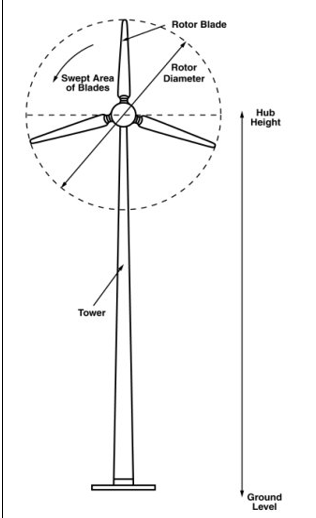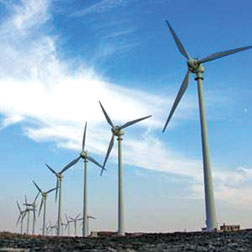Background
Under the current conditions, Sri Lanka remains to be a developing country with rather small income; stile, its citizens are eager to promote the development of the nation by a variety of means, and the idea of wind energy is not a new aspect that needs recognition. Chandrasena et al. (2006, p. 221) say that electricity has been always one of the main components of socio-economic development of the country, and the connection between Gross Domestic Product and the consumption of electricity continues playing an important role in society.
The investigations of Chandrasena et al. (2006, p. 221) show that the end of the year 2004 was rather productive and the wind power capacity has increased to 47.3 GW on the global level. Much attention is paid to the development of wind energy in large cities in order to help people save their money and spend them on other important items; this is why the development of wind energy in rural areas of Sri Lanka does not undergo some changes and improvements (Balakrishnan 2006).
The citizens of Shikalabuna are shot of the possibility to implement the required wind turbines and get a chance to pay less using the natural source available. In Pakistan, wind energy has been already used for about 300 years (Mirza et al. 2007, p. 2182). Thought the vast majority of time wind power aimed at providing some mechanical power in order to grind grain or other agricultural activities, the technological progress promotes wind energy as one of the most beneficial and effective resources of alternative energy.
Project Description
Overview
For a long period of time, electricity has been a crucial utility in many people’s lives. Taking into consideration the issue of globalisation, people of Shikalabuna change their lifestyles and regard the improvements of the technological facilities, and the use of electricity becomes an ordinary thing that is required 24/7 (“Electricity from Wind”). At the beginning of 1999, the idea to use energy from wind was implemented in society. People are free to choose the best technologies they are in need of, and Sri Lanka’s government is ready to provide people with the necessary choice.
Implementation
Mercy Corps is the community that is able to coordinate several local manufacturers to promote the necessary improvements in the village. Shikalabuna is rich in a number of natural sources such as sun, wind, animal waste, water streams, etc., this is why it is not a surprise to observe the citizens of Sri Lanka being able to use their natural richness in order to improve their lives and promote appropriate working conditions. It seems to be an easy task for manufacturers to find an appropriate place where wind turbines may be installed. If some unsafe background is observed on the land, it is necessary to strengthen the ground to be sure the quality of turbines is high.
Technology
In Shikalabuna, small wind systems will be elaborated as it is the pilot attempt to use wind energy as the main source and not all citizens are ready to participate in the chosen experiment. 10 houses are used in the project, and 10m tall and 250W wind turbines will be implemented. These turbines are designed to meet the needs of the citizens. Hewage (2010) admits that the Puttalam District of Sri Lanka is the place where three powerful wind energy plants are located. The results of the implementation of such turbines are impressive indeed: more than 40 gigawatts of energy have been added to the national grid by means of proper use of wind.

Environmental Benefits

One of the most significant merits of wind energy is lower rates of air and land pollution. The environmentally friendly nature of wind farms offered to the citizens of Shikalabuna continues attracting people’s attention (Jagadeesh 1999, p. 157). The citizens also understand that wind energy is a natural resource that will never be exhausted for the land.
Local Livelihood Benefits
Economy
The sphere of taxes may be considerably improved in case people try to make use of their natural sources and consider wind energy as the only rationale source. It is hard to imagine everyday live without electricity, still, it is not always possible to pay for electricity offered to society, this is why wind energy seems to be a justified alternative to pay attention to.
Local Opportunities
People of Shikalabuna are free to change their lifestyles and develop communications on different levels. The possibility to watch TV, listen to radio, and exchange information is now available to the citizens. The point is that those citizens who do not have access to electricity due to inabilities to use wind turbines may use help offered by the citizens who have an access. Wind energy is not as expensive as some people may think.
National Benefits
The citizens of the village may promote their services and their skills with other people. The attempt to settle wind turbines will also make the village recognizable as another land that benefits from wind energy.
Partnership
Mercy Corps will be interested in the development of wind turbines on the rural areas of Sri Lanka as the main purpose of this community is to promote peaceful and harmless development of villages.
Observing such amazing achievements, the government of Sri Lanka finds it beneficial to promote wind power industry and help citizens define the most appropriate sources of electricity to their homes.
Lessons Learned
Barriers
The main disadvantage of wind energy implementation is inability to calculate the required costs within a short period of time and ask the government for appropriate funds at the very beginning of the project.
Management
Implementation of wind turbines in rural areas requires much time and a number of calculations. Gipe (1999) says that evaluation of wind speed distribution is required as energy as well as wind is a type of power that has to be considered through some period of time. This is why talking about natural sources and the necessity of wind power turbines in such countries like Sri Lanka, it is very important to focus on different aspects and understand not only the urgency of cheap electricity but also the readiness of the country for a number of technological improvements.
Scaling Up
- Good relations with government that is interested in the improvements of living conditions in rural areas of Sri Lanka;
- Involvement of manufacturers into the project by means of underlying the merits of electricity in rural areas and people desire to pay for living conditions’ improvement;
- Merits Corps has a chance to demonstrate its possibilities and make use of small wind systems in order to achieve its main goal and help people live better and make less harm to environment.
Reference List
Balakrishnan, J 2006, “Renewable Energy and Distributed Generation in Rural Villages”, First International Conference on Industrial and Information Systems, pp. 190-195.
Chandrasena, RPS, Vikkitharan, G, Arulampalam A, & Ekanayake,JB 2006,: “Constraints for the development of wind power generation in Sri Lanka”, First International Conference on Industrial and Information System, pp. 221-226.
Electricity from wind, 2009. Web.
Gipe, P 1999, Wind energy basics: A guide to small and micro wind systems. Chelsea Green Publishing, White River Junction.
Hewage, I 2010, ‘High potential for wind power in Sri Lanka. Five new plants to be built. 300MW of power to be added’. Web.
Jagadeesh, A 1999, “Wind energy development in Tamil Nadu and Andhra Pradesh, India Institutional dynamics and barriers – A case study”, Energy Policy, 28, pp.157-168.
Mirza, UK., Ahmad, N, Majeed, T, Harijan, K 2007, “Wind energy development in Pakistan”, Renewable and Sustainable Energy Reviews, 11, pp. 2179-2190.